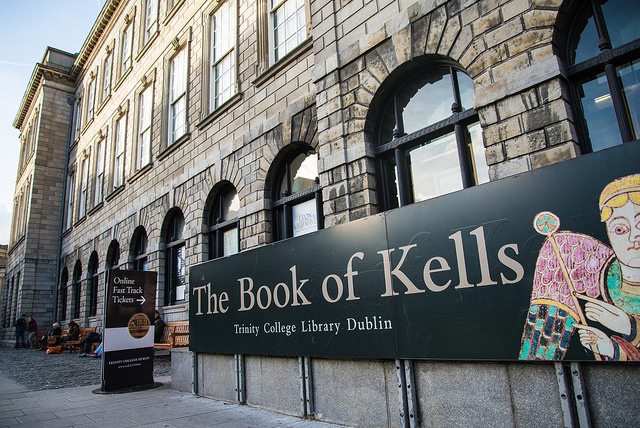Trinity’s Old Library is set for a major reconfiguration, which will see many of its oldest manuscripts moved to a new research space on the ground floor and involve the embedding of the library’s shop into the podium outside the Berkeley.
The revamp, which will significantly alter the way tourists interact with the building, is part of a College strategy to improve the conditions in a library that houses some of its oldest manuscripts and book collections.
Speaking to The University Times, the College Bursar, Veronica Campbell, said the move will involve “taking the shop out of the ground floor” and embedding it into a space located underneath the Berkeley podium. The library’s Early Printed Books section, as well as its manuscripts reading room, will move into the space vacated by the shop.
Campbell said that the project is currently in the design phase, but that Trinity is “aiming, by the end of this year, to submit for planning permission”.
She said that Early Printed Books and the manuscript reading room of the Old Library are currently “not of international standing in terms of quality”, and that the new research and study space on the ground floor will be “bigger and a better environment”.
The space will be located on the north face of the building, she said, “because that’s better light conditions for readers as well”.
The Book of Kells is set to stay in its current location in the library, she said, and “stepping into Long Room should look more or less the same as it looks now”.
Campbell said the upgrade is “not a radical overhaul and refurbishment – it’s actually dealing with the environmental issues so that the building still serves as a functioning library, but everything in it is in better condition in terms of environmental supports and quality of air”.
But the layout of the building, as well as tourists’ entry and exit points, will change dramatically. Under the plans for the library, tourists will enter and exit through the shop’s new location in the Berkeley podium as part of the expansion of an existing link between the library and the podium.
The shop will occupy a space beneath the Berkeley that was previously used to store books. These books have been moved to one of Trinity’s off-site storage facilities, Campbell said.
She said that “a major part of the project” will be improved environmental controls. These controls, she added, will “protect the building and the collections”.
The College has contracted Heneghan Peng Architects to help design the Old Library, and will organise “various information events and engagement with Dublin City Council” over the year.
Since 2004, Trinity has been involved in an ongoing project to preserve its Old Library, which was built in the 1720s.
The project involves removing dirt from valuable books, replacing leather book binding, and making custom enclosures for fragile items.
In recent years, Trinity’s Preservation and Conservation department has also investigated pollution levels and other environmental hazards in the Old Library, which pose serious threats to the preservation of the collections.
Last year, the College Estates Strategy called the Old Library “extraordinarily significant”. “Whilst there are plans for improving the visitor experience there is also an academic need for renewal”, the report stated.
The document said that conserving the library’s materials, and creating a new research collections study centre, “is a core need of any library strategy”.
“The Berkeley is another architectural gem but restricted in its flexibility due to the original design. The Ussher is modern and generally fit for purpose whilst the Lecky is well located and exible but is very tired and shabby”, the report said.
It said that there is a need to reduce the volume of collections held on the main campus, “to improve the quality and quantity of reader spaces along with general updating”. However, the report deemed Trinity’s Santry stacks depository, which houses the majority of the College’s books, “not fit for purpose”.
“The collections are being kept in conditions that are not appropriate for an institution with the reputation of Trinity and the statutory responsibility for legal deposit material”, the report said. As the deposit is now full, the College must send all the additional materials it acquires to commercial storage, costing Trinity hundreds of thousands of euros every year.
“It is critical for the collections and the finances of Trinity that there is a depository solution. It also provides scope to re-imagine the library system.”
In addition to the financial need for the College to source additional storage for library materials, the report said that it “could provide capacity for growth in Arts Humanities and Social Sciences by making additional space available in the Lecky, and, pending a feasibility study, the basement area of the 1937 Reading Room for student learning spaces and postgraduate write up spaces, respectively”.
The report said that “this project has significant self-financing elements to it”.
A major driver of commercial income is the Book of Kells exhibition and associated shop. Visitor numbers to the Book of Kells exhibition in Trinity have increased by almost eight per cent since last year, with 1,057,642 people visiting the world-famous medieval manuscript. This was an increase of 7.5 per cent from 2017. The exhibition was the fourth-most visited tourist attraction in Ireland in 2018.
In 2018, the exhibition welcomed its record-breaking millionth visitor, a bookshop owner from Oregon in the US. American visitors make up 36 per cent of all ticket sales to the exhibition.
The Book of Kells is carefully maintained, with the pages turned every six weeks to prevent light damage and to allow the public to view different sections of the book.
Last year, the Book of Kells was removed from its display and replaced with a copy due to “technical difficulties”. The real book was replaced with a fine art facsimile, which is an exact copy of the original.







